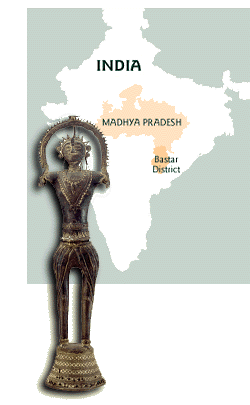|
Chapter 2: Background Information for Teachers |
|
||||||||||||

|
Mata The people of the Gond tribe in Bastar District in central India often worship the Mother Goddess, generically known as Mata. Descended from the subcontinent's earliest inhabitants, the Gonds have been influenced by Hindus who have settled in the region. Over time they have synthesized their ancestral worship with Hindu rituals. Although they worship male gods as well, most often their focus of devotion is the Mother Goddess. Frequently the deity herself is represented only by a wooden post or log, although her image may also be carved in stone or cast in bronze. Bronze images of Mata in her many forms are given to the goddess by her devotees in gratitude for answered prayers. They become a link between the devotee and the deity that will be reaffirmed at each subsequent puja. These small bronzes are not normally on view. They are stored in a basket or box and placed in the shrine only for special occasions. At that time they are washed with holy water and mustard oil and adorned with leaves, rice, and flowers. A shaman then invites Mata's spirit into his body. In a trance he speaks with the voice of the goddess, accepting the new bronze image and acknowledging its donor. Above left: Figure of the Goddess (Mata). Bastar District. Madhya Pradesh, 19th-20th century. Bronze, 45.6 x 12.1 x 9.9 cm. Lent by Paul F. Walter, LTS1992.10.102a-b | ||||||||||||